Focus on spectral sensing and optoelectronic application systems
Supercontinuum Laser White Light Source
LiSen Optics has addressed the limitations of traditional radiometric calibration light sources, such as deuterium lamps, quartz window halogen tungsten lamps, and long-arc xenon lamps, which often fail to maintain high output across the 200 nm to 800 nm spectral range. These traditional sources also require recalibration after as little as 100 hours of use and bulb replacement after about 500 hours.
LiSen Optics has addressed the limitations of traditional radiometric calibration light sources, such as deuterium lamps, quartz window halogen tungsten lamps, and long-arc xenon lamps, which often fail to maintain high output across the 200 nm to 800 nm spectral range. These traditional sources also require recalibration after as little as 100 hours of use and bulb replacement after about 500 hours.
Product Introduction
By utilizing single-point laser-driven light source technology, LiSen Optics has developed a class of light sources that not only provide exceptionally high luminance across an extended spectral range from 170 nm to 2100 nm but also significantly increase the lifespan of the light source by an entire order of magnitude compared to traditional options. This advancement greatly enhances the utility and efficiency of light sources in a variety of applications, reducing the frequency of maintenance and the overall cost of operation while providing broader spectral coverage.。
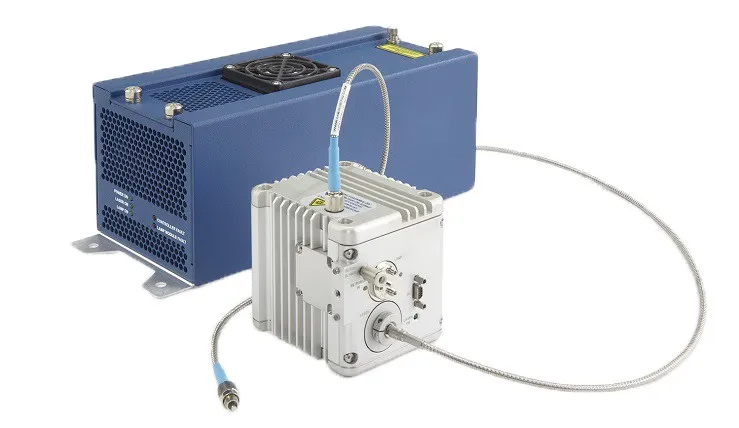
By utilizing single-point laser-driven light source technology, LiSen Optics has developed a class of light sources that not only provide exceptionally high luminance across an extended spectral range from 170 nm to 2100 nm but also significantly increase the lifespan of the light source by an entire order of magnitude compared to traditional options. This advancement greatly enhances the utility and efficiency of light sources in a variety of applications, reducing the frequency of maintenance and the overall cost of operation while providing broader spectral coverage.。

Product Features and Advantages
1. Broad Spectral Range and High Brightness:
· Capable of producing ultra-high brightness with a 100 µm scale luminous plasma, covering a wavelength range from 170 nm to 2100 nm.
2. High Irradiance:
· Offers irradiance levels greater than 10-100 mW/mm.sr.nm (wavelength-dependent), facilitating ultra-fast measurements.
3. Flexible Optical Output:
· Provides options for fiber-coupled or free-space beam outputs, offering high optical flexibility to suit various experimental setups.
4. Electrodeless Structure:
· Features an ultra-long lifespan, ultra-high stability, and significantly reduced costs due to the absence of electrodes in the light generation process.
Structure and Operating Principle
Unlike traditional electroluminescent light sources that utilize high voltage across electrodes to excite gas discharge within the lamp chamber, the supercontinuum laser white light source operates on a distinct principle. This advanced light source uses an external laser, typically around 1000 nm wavelength, which is focused into the lamp chamber to heat the plasma. As the plasma reaches a sufficient temperature, it emits light.
Traditional sources like arc lamps, xenon lamps, and argon lamps are limited in brightness, UV power output, and lifespan due to the use of electrode-coupled plasma generation. In contrast, the supercontinuum laser white light source employs electrodeless laser-driven technology, which allows for efficient light collection. This technology can provide exceptionally high luminance over a broad spectral range—from deep ultraviolet to visible light and beyond—extending the life of the light source by an order of magnitude compared to conventional sources.
The overall structure of the supercontinuum laser white light source includes a specially designed lamp chamber, a driving laser source, laser focusing optics, an output light path, and a light source controller. These components work together to offer a superior performance that is ideal for scientific research and industrial applications requiring precise and intense light across a wide spectral range.
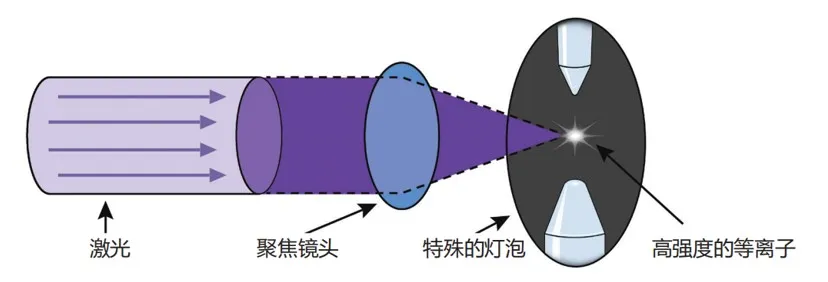
Structure and Operating Principle![]()
Product Features and Advantages
1. Broad Spectral Range and High Brightness:
· Capable of producing ultra-high brightness with a 100 µm scale luminous plasma, covering a wavelength range from 170 nm to 2100 nm.
2. High Irradiance:
· Offers irradiance levels greater than 10-100 mW/mm.sr.nm (wavelength-dependent), facilitating ultra-fast measurements.
3. Flexible Optical Output:
· Provides options for fiber-coupled or free-space beam outputs, offering high optical flexibility to suit various experimental setups.
4. Electrodeless Structure:
· Features an ultra-long lifespan, ultra-high stability, and significantly reduced costs due to the absence of electrodes in the light generation process.
Structure and Operating Principle
Unlike traditional electroluminescent light sources that utilize high voltage across electrodes to excite gas discharge within the lamp chamber, the supercontinuum laser white light source operates on a distinct principle. This advanced light source uses an external laser, typically around 1000 nm wavelength, which is focused into the lamp chamber to heat the plasma. As the plasma reaches a sufficient temperature, it emits light.
Traditional sources like arc lamps, xenon lamps, and argon lamps are limited in brightness, UV power output, and lifespan due to the use of electrode-coupled plasma generation. In contrast, the supercontinuum laser white light source employs electrodeless laser-driven technology, which allows for efficient light collection. This technology can provide exceptionally high luminance over a broad spectral range—from deep ultraviolet to visible light and beyond—extending the life of the light source by an order of magnitude compared to conventional sources.
The overall structure of the supercontinuum laser white light source includes a specially designed lamp chamber, a driving laser source, laser focusing optics, an output light path, and a light source controller. These components work together to offer a superior performance that is ideal for scientific research and industrial applications requiring precise and intense light across a wide spectral range.

Structure and Operating Principle![]()
Performance Advantages
● High Brightness
● High Brightness Source:
The supercontinuum laser white light source is considered a high-brightness source because it can emit intense light from a very small point.
● Applicability:
As a high-brightness source, it is particularly suited for imaging applications and for measuring small objects such as microchips and biological cells.
● Strong Light Emission:
The supercontinuum laser white light source can emit exceptionally strong light from a 100 µm scale light point.
● Ultra-Small Point Imaging:
Imaging of extremely small areas (<<1mm) is made easier with this technology.
● Ease of Coupling:
The supercontinuum laser white light source more readily couples into fiber optics and spectrometers, enhancing usability in various optical setups.
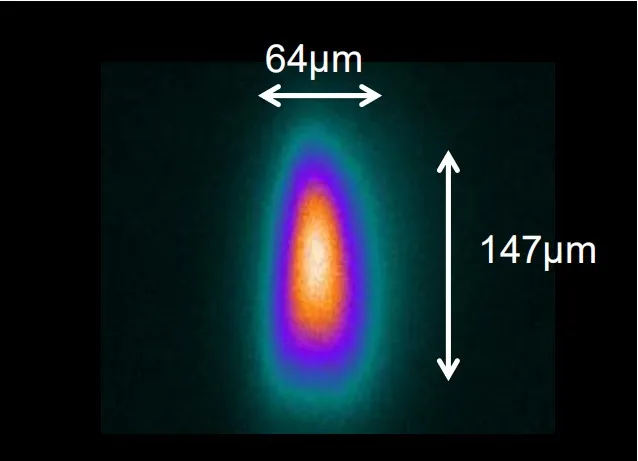
Broad Spectral Distribution
1. Spectral Coverage: The spectrum of the supercontinuum laser white light source covers a range from deep ultraviolet to visible to near-infrared.
2. Flat Spectral Distribution: The distribution across the spectrum is notably even.
Exceptional UV Spectral Intensity: Provides ultraviolet spectral intensity that is more than ten times greater than what traditional light sources can offer.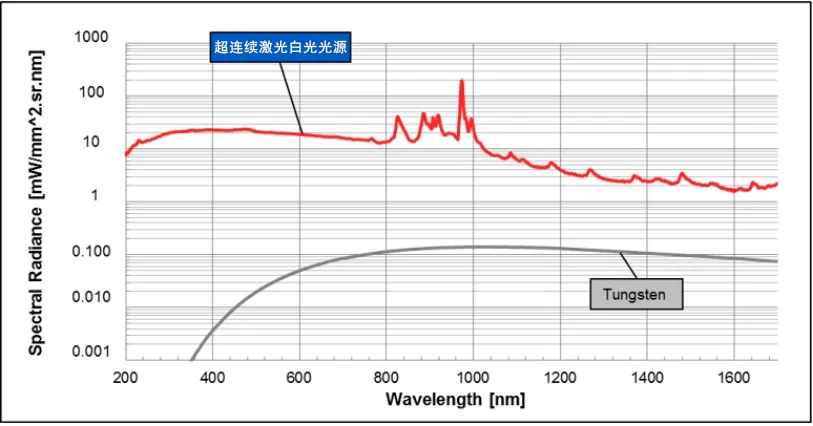
Free Space vs. Fiber Coupled Output
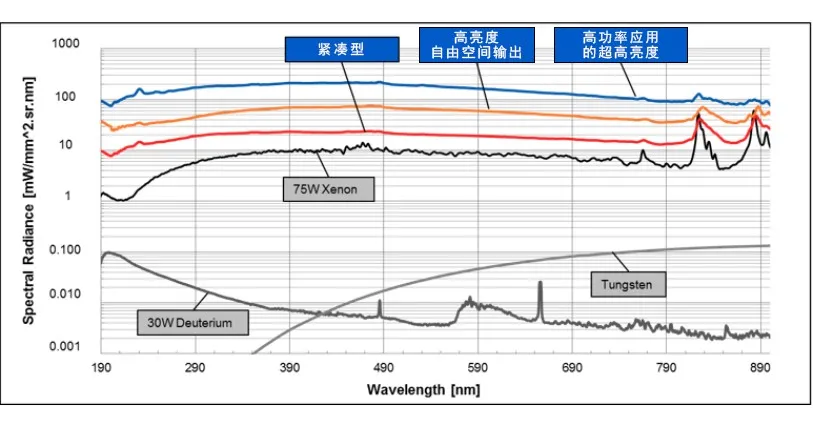
Intensity Distribution Comparison
Longevity and High Stability
1. Extended Lifespan: Features a remarkably long lamp chamber lifespan, typically exceeding 9000 hours, which results in lower consumable costs.
2. Extended Calibration Intervals: Compared to traditional sources (xenon, deuterium, halogen lamps), this source exhibits much lower drift, allowing for longer periods between calibrations.
Stability Comparison
|
Light Source Type |
Spectral Output Change Over 1000 Hours (Typical) |
Typical Lifespan (Hours) |
|
Compact Supercontinuum Laser White Light Source |
~-1% |
>10,000 |
|
Neon Lamp |
-25% (depends on the model) |
2,000 |
|
Argon Lamp |
-50% (depends on the model) |
1,000 |
The extremely high spatial stability of the plasma is demonstrated through the following method:
● Images of the luminous plasma are captured and stored at a rate of 200 frames per second, totaling 2500 images.
● The centroid of each image is calculated using ImageJ, an image analysis software.
● The standard deviation of the luminescent plasma centroid position is:
In the horizontal direction: 0.145µm
In the vertical direction: 0.094µm
Performance Advantages
● High Brightness
● High Brightness Source:
The supercontinuum laser white light source is considered a high-brightness source because it can emit intense light from a very small point.
● Applicability:
As a high-brightness source, it is particularly suited for imaging applications and for measuring small objects such as microchips and biological cells.
● Strong Light Emission:
The supercontinuum laser white light source can emit exceptionally strong light from a 100 µm scale light point.
● Ultra-Small Point Imaging:
Imaging of extremely small areas (<<1mm) is made easier with this technology.
● Ease of Coupling:
The supercontinuum laser white light source more readily couples into fiber optics and spectrometers, enhancing usability in various optical setups.

Broad Spectral Distribution
1. Spectral Coverage: The spectrum of the supercontinuum laser white light source covers a range from deep ultraviolet to visible to near-infrared.
2. Flat Spectral Distribution: The distribution across the spectrum is notably even.
Exceptional UV Spectral Intensity: Provides ultraviolet spectral intensity that is more than ten times greater than what traditional light sources can offer.
Free Space vs. Fiber Coupled Output

Intensity Distribution Comparison
Longevity and High Stability
1. Extended Lifespan: Features a remarkably long lamp chamber lifespan, typically exceeding 9000 hours, which results in lower consumable costs.
2. Extended Calibration Intervals: Compared to traditional sources (xenon, deuterium, halogen lamps), this source exhibits much lower drift, allowing for longer periods between calibrations.
Stability Comparison
|
Light Source Type |
Spectral Output Change Over 1000 Hours (Typical) |
Typical Lifespan (Hours) |
|
Compact Supercontinuum Laser White Light Source |
~-1% |
>10,000 |
|
Neon Lamp |
-25% (depends on the model) |
2,000 |
|
Argon Lamp |
-50% (depends on the model) |
1,000 |
The extremely high spatial stability of the plasma is demonstrated through the following method:
● Images of the luminous plasma are captured and stored at a rate of 200 frames per second, totaling 2500 images.
● The centroid of each image is calculated using ImageJ, an image analysis software.
● The standard deviation of the luminescent plasma centroid position is:
In the horizontal direction: 0.145µm
In the vertical direction: 0.094µm
Application
1. UV-Visible Spectral Analysis
2. Monochromator light source
3. Thin film inspection
4. Filter/optical component testing
5. Atomic absorption spectroscopy
6. Material Characteristics Detection
7. Environmental Analysis
8. Hyperspectral imaging
9. Gas phase analysis measurement
10. Optical sensor detection
11. Life Sciences and Bioimaging
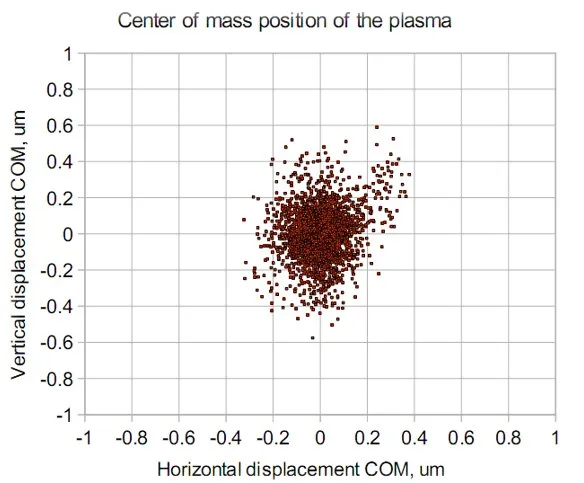
Application
1. UV-Visible Spectral Analysis
2. Monochromator light source
3. Thin film inspection
4. Filter/optical component testing
5. Atomic absorption spectroscopy
6. Material Characteristics Detection
7. Environmental Analysis
8. Hyperspectral imaging
9. Gas phase analysis measurement
10. Optical sensor detection
11. Life Sciences and Bioimaging

Prev: Xenon Arc Lamp
Send Inquiry
